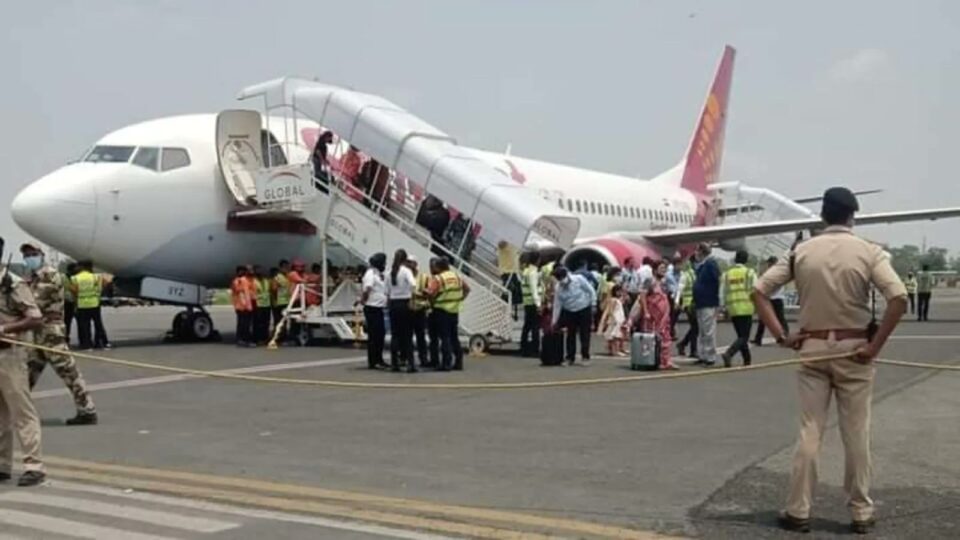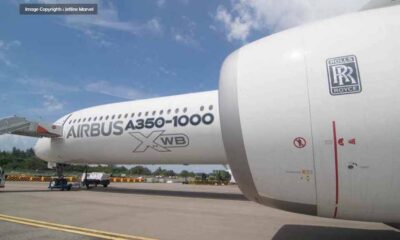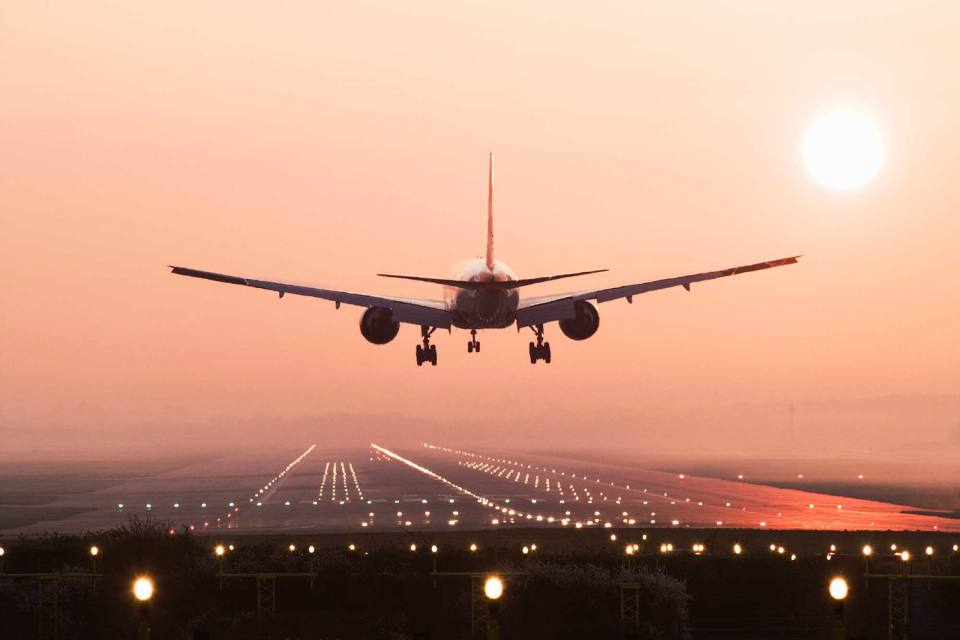Aviation
Spice Jet suffers 7 emergency landings in 17 days, trouble brewing for airline.

On Tuesday, a Spice Jet flight from Delhi to Dubai suffered a fuel indication malfunction in the air and had to be diverted to Karachi. At a height of 23,000 feet, the windshield of another Spice Jet started to break, necessitating an urgent landing in Mumbai. The budget airline suffered two defeats in a single day, bringing the total number of technical fault issues involving Spice Jet aircraft to seven during the previous 17 days. Although neither of the two parties in this case has made a statement, officials of the Directorate General of Civil Aviation (DGCA) claim that the aviation regulator of India is looking into each of the seven events and may take actions against the airline if it determines that it is at fault.
Regarding the seven incidents, six were domestic flights and one was an international flight. On June 5 in the early morning, a Spice Jet Boeing 737 Max carrying about 150 passengers on a trip from Delhi to Dubai was reported to have an international flight incident when it made an emergency landing in Karachi, Pakistan. While in the air, the plane began to exhibit an odd fuel quantity reduction from its left tank, which caused it to be redirected to Karachi.
When an inspection was done at the Karachi airport, no visual leak was observed from the left tank, they added. Spice Jet deputed another aircraft from India in the evening and by 10 PM in the night, all passengers left for Dubai again, spending 12 hours in Pakistan.
In the second incident, the Q400 plane’s windshield cracked at a height of 23,000 feet, forcing the pilots to make a quick landing at the Mumbai airport, according to DGCA officials. It was not immediately known how many people were travelling on the 78-seat Q400 aircraft on the Kandla-Mumbai journey. According to them, the aircraft had no problems with cabin pressurization. “Spice Jet Q400 aircraft was flying SG 3324 on July 5th, 2022. (Kandla-Mumbai). At FL230 (23,000 feet above sea level), the P2 side windshield outer pane cracked. It was noted that pressurization was typical. The plane touched down safely in Mumbai “In a statement, Spice Jet said.
On June 19, the carrier’s flight bound for Delhi with 185 passengers experienced an engine fire shortly after departure from Patna airport and necessitating an emergency landing. Because of the bird strike, the engine broke down. The plane’s pilot, Monica Khanna, is given credit for a successful landing after one of the most significant occurrences in recent days.
In another incident on June 19, a flight for Jabalpur had to return to Delhi due to cabin pressurization issues. Fuselage door warnings lit up on two separate planes while taking off on June 24 and June 25, forcing them to abandon their journeys and return.
On July 2, a flight to Jabalpur made a turn back to Delhi when the crew noticed smoke in the cabin at a height of about 5,000 feet.
One more on 5th of july, Due to a malfunctioning weather radar, a Spice Jet cargo flight headed for China made a Tuesday return to Kolkata. The Spice Jet cargo Boeing 737 was supposed to fly from Kolkata to Chongqing, however the spokesperson said that after takeoff it was discovered that the weather radar was inoperable. The pilot-in-command made the decision to return to Kolkata and successfully touched down there.

Aviation
South Korea Introduces Cutting-Edge MRO Center for F-35 and IAI

South Korea is set to make waves in the aerospace industry with the establishment of a cutting-edge Maintenance, Repair, and Overhaul (MRO) hub for F-35 fighter jets and IAI (Israel Aerospace Industries) aircraft.
Central to this initiative is the specialization in converting Boeing 777-ERSF, colloquially known as the “Big Twin,” from passenger to freighter configurations. Under the terms of the agreement, IAI will spearhead the conversion of six B777-300ER and B777-200LR aircraft annually, commencing in 2024. This strategic move is in response to the anticipated surge in demand for wide-body freighter aircraft capable of long-haul flights.
Furthermore, South Korea’s forward-looking vision extends beyond aircraft conversion, with plans to establish a Lockheed Martin F-35 maintenance, repair, and overhaul depot at Cheongju Air Base by 2027. This strategic move not only enhances the operational readiness of South Korea’s air force but also positions the nation as a regional hub for F-35 maintenance expertise.
In preparation for this expansion, thirty Republic of Korea Air Force (ROKAF) engineers and technicians are slated to undergo intensive maintenance training in the United States in 2025, a testament to South Korea’s commitment to fostering local expertise and talent.
IAI’s visionary approach to certification and collaboration underscores the potential for transformative change. With plans for the 777-300ERSF certification process set to unfold in Israel, followed by the rigorous scrutiny of regulatory agencies such as the US Federal Aviation Administration (FAA), the stage is set for the ‘Big Twin’ to soar to new heights of success.
In partnership with esteemed entities like STK and Incheon International Airport Corporation, this collaboration promises to unleash a wave of benefits, amplifying the resilience and competitiveness of the Korean aviation sector while catalyzing job creation and economic prosperity.
Aviation
Lockheed Martin Expresses Interest in Joining AMCA Project

Lockheed Martin, a leading global aerospace and defense company, is demonstrating its dedication to strengthening collaborations with India’s research, industry, and academic sectors. With its rich experience in the aerospace industry and renowned for building some of the world’s most advanced jets, Lockheed Martin is now exploring opportunities to contribute to India’s aerospace sector, potentially providing a significant boost to aerospace technology in the country.
Randy Howard, Vice President of Global Pursuits at Lockheed Martin Aeronautics, recently underscored their interest in exploring “advanced transfer of technology opportunities” with Indian partners, signaling a proactive approach towards fostering technological exchange and advancement in the aerospace domain.
India has been at the forefront of fighter jet development since the 1970s, having produced its own cost-effective fighter jets and combat helicopters, while continually upgrading to maintain competitiveness on a global scale.
Lockheed Martin stands as a dominant force in the aircraft industry, renowned for developing cutting-edge planes like the F35 and F22, some of the most advanced fighter jets globally. They’ve also contributed to projects like the South Korean KF21 aircraft for defense purposes through collaborations.
Now, Lockheed Martin has set its sights on India’s defense sector manufacturing processes, expressing interest in partnering with India on its most anticipated project, the Advanced Medium Combat Aircraft (AMCA), likely to be a 5th generation fighter jet for the Indian military.
Their proposed collaboration could involve a spectrum of advanced technologies, including the Auto Ground Collision Avoidance System (Auto GCAS), a life-saving technology that intervenes to prevent ground collisions, thus significantly enhancing flight safety for Indian pilots.
Lockheed Martin is extending its expertise to design and develop an indigenous cockpit for the F-21 fighter jets, which India is procuring. This collaboration with Tata also includes the development of fighter jet wings. Established in 2023, this partnership adopts a “Ground Floor Design” strategy aimed at equipping India with an in-depth comprehension of 5th-generation cockpit technology and Man-Machine Interface (MMI) systems.
As India’s Fighter jet program advances with finalized aircraft frame and engine prototypes, Lockheed Martin has expressed interest in joining the project. They see a groundbreaking opportunity in cooperative 5th Generation Fighter Development, potentially expediting the AMCA program’s progress through technology and expertise sharing.
Furthermore, Lockheed Martin is keen on collaborating on large-wing, jet-powered UAV platforms, which could enhance India’s unmanned aerial capabilities.
While discussions are ongoing, and specific collaboration details await finalization, this initiative represents a potentially transformative stride in India’s aerospace self-reliance journey and Lockheed Martin’s strategic engagement with the Indian market.
Aviation
Can Airline Seat Cushions Be Used As Life Jackets?

In the event of an aircraft ditching into water, there’s a common question: Can aircraft seats serve as an alternative to life jackets for flotation? The answer lies in understanding their respective functions.
While seat cushions can provide some buoyancy in water, they are not intended nor certified to function as life jackets. Their primary purpose is to offer cushioning for passengers during flight. On the other hand, life jackets are meticulously engineered to keep individuals afloat in water, equipped with buoyancy materials, secure straps, and reflective elements for visibility. They offer numerous advantages over mere cushions.
While a seat cushion might offer temporary assistance in staying afloat, it’s not a dependable substitute for a proper life jacket during an emergency. It’s crucial to utilize approved safety equipment when near bodies of water. A life jacket, designed to keep a person buoyant for extended periods, offers the rigidity needed for prolonged flotation and allows for easy movement of the arms to navigate effectively.
What fabric is used in aircraft seats?
Seats are meticulously designed to fulfill multiple purposes, ensuring passenger comfort, safety, and protection from unforeseen circumstances like fires and accidents. A typical design incorporates an aluminum frame with blocks of polyurethane foam affixed to it. Additionally, a layer of fire-resistant fabric, such as Kevlar or Nomex, is often applied over this framework, topped with a layer of cloth or leather.
Leather seats, while luxurious, are more expensive compared to traditional cloth seats. The majority of fabrics used in seat upholstery contain at least 90% wool fiber, with the remainder typically consisting of polyamide (nylon). Wool stands out as the primary fiber chosen for commercial airline seating fabric due to its desirable properties and suitability for such applications.
What is the lightest economy seat?
In recent times, airlines have been downsizing seat dimensions to accommodate more passengers, resulting in reduced cushion length and leg space. This contrasts with earlier times when airlines offered more generously cushioned seats and ample amenities.
According to Recaro Seats Company, their SL3710 model represents the lightest economy class seat available, weighing in at a mere 8 kg (17.6 lb.), setting a new standard in aircraft seating.
For individuals weighing more than 350 pounds, fitting into a standard economy-class seat can be a challenge due to the narrower dimensions. Economy seats, also referred to as “coach,” “standard,” or “main cabin” seats, typically range from about 40 to 48 centimeters in width, further emphasizing the need for more accommodating seating options.


























